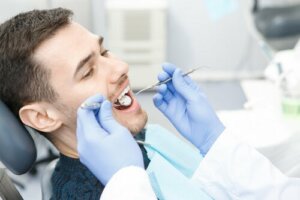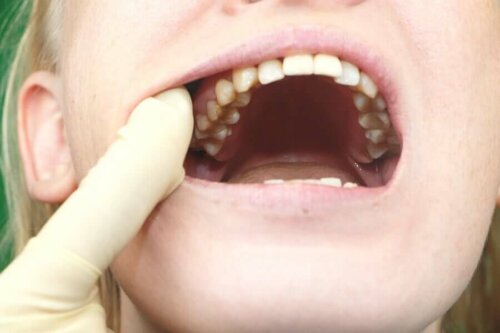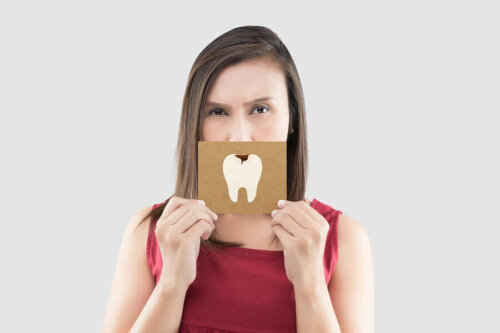Bacteria that Cause Cavities


Written and verified by the doctor Leonardo Biolatto
Bacteria that cause cavities are microorganisms that organize themselves in a biofilm called dental plaque. In practice, this is seen as a white spot on the tooth, and, as the decay progresses, a cavity forms, exposing the dentin.
This process includes several stages in which the bacteria that cause cavities also alternate: in each phase one of them predominates. In general, Streptococcus mutans bacteria are present at the beginning of the process, while Lactobacillus and Bifidobacterium predominate in the advanced stages.
Although everyone has microorganisms in their mouths, bacteria that cause cavities aren’t present in healthy individuals. Among those who have teeth in perfect condition, the Streptococcus sanguinis species predominates.
Cavities
A cavity is the destruction of dental tissues by acids produced by bacteria grouped in dental plaque. This is a film formed on the teeth by bacteria that cause cavities.
There are several types of cavities:
- Crown: This is the most common form and happens on chewing surfaces. It occurs in both children and adults.
- Interdental or interproximal: This is the kind that appears in the spaces between the teeth, and isn’t easy to detect.
- Root: This occurs in adults, especially the elderly, and is due to the retraction of the gum. This exposes the root of the tooth, which doesn’t have enamel, and can be more easily affected.
- Recurrent or secondary: These are ones that appear next to fillings, caps, or crowns that dentists placed to treat other cavities.

Keep reading: Natural Teeth Whitening
Bacteria that cause cavities
Bacteria of the Streptococcus mutans species are the most numerous in dental plaque, with a high incidence at the beginning of cavities. This type of bacteria is gram positive, facultative anaerobic, and spherical. It belongs to the lactic acid bacteria group and grows in low pH environments.
These bacteria are transmitted from person to person and adhere to the teeth and gums, forming mounds. Frequently, and especially in deep cavities, they’re accompanied by bacteria such as S. salivarius, S. parasanguinis, and S. constellatus. You can avoid their spread with good dental hygiene habits.
In some cases of cavities, S. mutans isn’t present, but S. sobrinus, S. oralis and S. salivarius are. When a cavity is already there, the presence of various types of Lactobacillus is common, with a predominance of L. gasseri and L. ultunensis.
Other relevant bacteria
Other bacteria that cause cavities are Actinomyces, which are particularly present in many cases of root cavities. However, its role in the onset and progression of the condition isn’t clear. This bacterium is one of the first to colonize children’s mouths.
Bifidobacteriums are anaerobic bacilli that group together in the form of a branch, and are usually present in the healthy intestinal tract. The B. dentium, S. inopinata (B. inopinatum), and P. denticolens (B. denticolens) have been found in several cases, appearing when the cavity is already advanced.
Prevotella is another anaerobic bacillus, and one of the most common in the oral cavity. It has been associated with periodontal disease and endodontic infections, but the role it plays in cavities is unclear. On the other hand, Veillonella is very numerous in healthy mouths.

Discover more: These Foods Cause Yellow Teeth
How to fight bacteria that cause cavities?
There are several factors that promote the growth of bacteria that cause cavities. The first is excessive consumption of foods rich in carbohydrates, such as sugary drinks, sweets, and pastries. The more you eat, the greater the risk of developing cavities.
Other foods rich in starches, such as potatoes or bread, also promote the development of cavities. The way you eat them can also influence cavity formation. It’s better to eat these products at one time and not to eat small pieces over time. It’s also important to know how to combine them.
Good oral hygiene is key. We recommend you brush your teeth one hour after each meal. Also, use dental floss, a fluoride mouthwash and, of course, visit the dentist twice a year.
All cited sources were thoroughly reviewed by our team to ensure their quality, reliability, currency, and validity. The bibliography of this article was considered reliable and of academic or scientific accuracy.
- Gamboa, F., Acuña, B. H., & Martínez, M. C. (2004). Control microbiológico sobre Streptococcus mutans y su acción acidogénica. Universitas scientiarum, 9(Es2), 45-55.
- Pérez Quiñones, J. A., Duque de Estrada Riverón, J., & Hidalgo Gato-Fuentes, I. (2007). Asociación del Estreptococos mutans y lactobacilos con la caries dental en niños. Revista Cubana de Estomatología, 44(4), 0-0.
- Portilla Robertson, J., Pinzón Tofiño, M. E., Huerta Leyva, E. R., & Obregón Parlange, A. (2010). Conceptos actuales e investigaciones futuras en el tratamiento de la caries dental y control de la placa bacteriana. Revista odontológica mexicana, 14(4), 218-225.
This text is provided for informational purposes only and does not replace consultation with a professional. If in doubt, consult your specialist.








